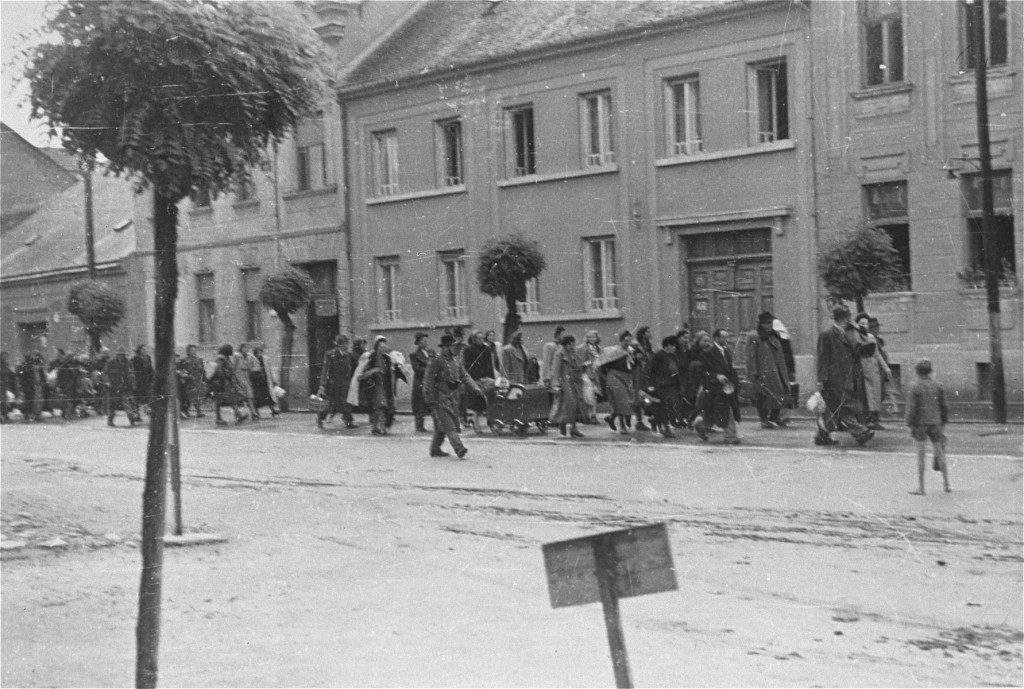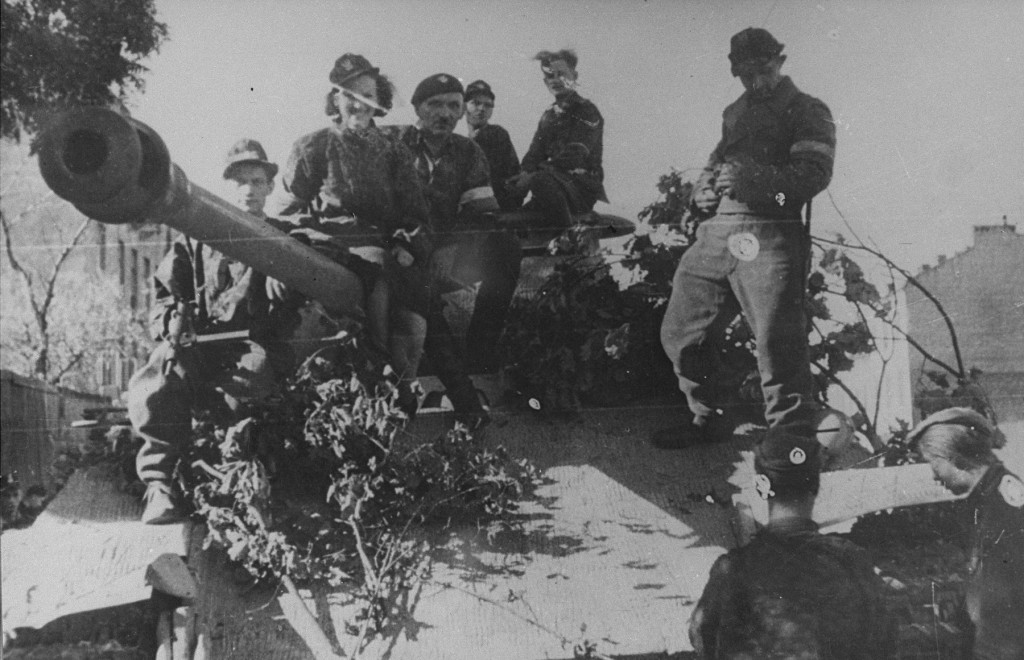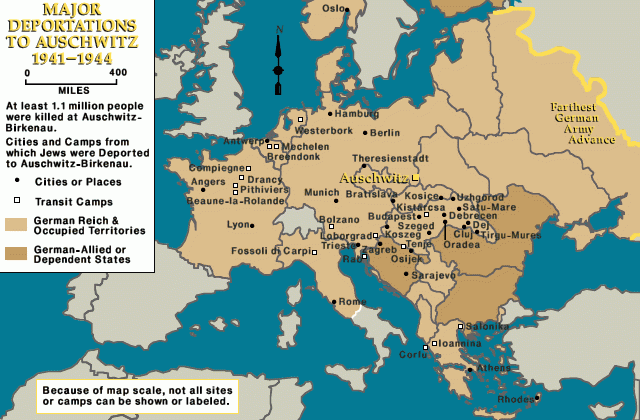
1944: Key Dates
January 22
US president Franklin D. Roosevelt issues Executive Order 9417, creating the War Refugee Board. Roosevelt instructs the War Refugee Board to take measures to rescue victims of enemy oppression in imminent danger of death. The activities of the War Refugee Board contribute to saving tens of thousands of Jews from deportation and death, possibly up to 200,000.
March 19
German troops occupy Hungary.

Early Spring
German authorities begin the evacuation of Lublin/Majdanek and deport the remaining inmates to Auschwitz, Natzweiler-Struthof, Ravensbrück, Plaszow, and Gross-Rosen.
April 5
Under German guidance, Hungarian authorities require all Jews to wear the yellow star.
April 16
German authorities begin to establish concentration points for the deportation of Jews from Hungary.
April 29–30
Hungarian authorities send the first two transports of Hungarian Jews into German custody.
May 15–July 9
Hungarian gendarmerie officials, under the guidance of German SS officials, deport around 440,000 Jews from Hungary. Most are deported to Auschwitz-Birkenau, where, upon arrival and after selection, SS functionaries kill the majority of them in gas chambers.
May 15–18
German authorities deport 7,003 German, Austrian, and Czech Jews from the camp-ghetto Theresienstadt to Auschwitz-Birkenau in order to “thin out” the Jewish population of Theresienstadt in preparation for the visit of representatives of the International Red Cross and the Danish Red Cross. Upon arrival in Auschwitz-Birkenau, the prisoners on these transports are incarcerated in a “Theresienstadt family camp” in Birkenau.
May 16
The SS attempts to liquidate the Gypsy family camp BIIe at Auschwitz. Having been tipped off by a camp official, the inmates, armed with knives, shovels, and other weapons, refuse to leave their barracks. As a result of internal disagreement and in the face of resistance from the prisoners, the SS postpones the liquidation of the family camp until August 1944.
June 6
On this day known as D-Day, British and American troops launch an invasion of France.
June 18-22, 1944
The Auschwitz Report, written by two Slovak Jewish prisoners who escaped from Auschwitz on April 7, 1944, and composed a report in Slovak by the end of April, goes public worldwide through media channels in Switzerland
June 22–August 1
Soviet troops destroy German Army Group Center in eastern Belorussia and sweep forward to the east bank of the Vistula River across from the center of Warsaw, Poland.
June 23
With the permission of the RSHA, representatives of the International Red Cross and the Danish Red Cross inspect a “specially prepared” Theresienstadt camp-ghetto.
June 23–July 14
The SS resumes deportations from the Lodz ghetto to the Chelmno killing center, deporting and killing more than 7,000 Jews.
June 24–August 14
War Refugee Board representative John Pehle and several US Jewish organizations including the World Jewish Congress make several requests to the US government to bomb the gas chambers at Birkenau or the rail lines leading to Birkenau. Assistant State Secretary of Defense John J. McCloy handles most of these requests. The US government declines the requests on the grounds that Auschwitz-Birkenau was not a military target, that such a mission would divert resources needed to bring the war to a successful conclusion, and that the speedy end of the war would be most effective in saving lives.
July 2
German authorities begin liquidating the labor camps in Wilno (Vilnius) and kill approximately 3,000 Jews in the Ponary (Paneriai) woods.
July 6
Regent Miklos Horthy of Hungary issues an order that the Hungarian government will cease deporting Jews from Hungary in Germany custody. Deportations halt on July 9.
July 8–12
As the Soviet army approaches, SS authorities liquidate the Kauen concentration camp, transferring around 8,000 Jews to the Stutthof and Dachau concentration camps in the German Reich.
July 9
Raoul Wallenberg arrives in Budapest as first secretary to the Swedish legation in Hungary and with financing from the US War Refugee Board. Along with numerous other legations, including the Swiss, the Turkish, the Italian, and several Latin American legations, the Sweden delegation, inspired by the activism of Wallenberg, effectively protects tens of thousands of Budapest Jews endangered by German and Hungarian plans to deport them.
July 13
The Soviet army liberates Wilno (Vilnius) in Lithuania.
July 23–24
Soviet troops liberate Lublin/Majdanek concentration camp. Although they had evacuated most of the remaining prisoners westward to evade the advancing Soviet army, the SS camp authorities are surprised by the rapid Soviet advance and fail to destroy the camp and the evidence of mass murder.
July 25–September 15
Allied forces break out of the Normandy beachhead, routing the German defenders. On August 25, Free French troops liberate Paris; by September 15, US troops will reach the German border.
August 1
The Soviet army liberates the city of Kaunas.

August 1–October
The underground Polish Home Army rises against the Germans in an effort to play a role in the liberation of Warsaw.
August 2
The SS liquidates the Gypsy family camp BIIe at Auschwitz-Birkenau. The SS authorities transport 1,408 Roma from the family camp and from Auschwitz I to Buchenwald concentration camp. SS men then murder the remaining 2,897 inmates of the Gypsy family camp in the gas chambers at Birkenau.
August 6
SS authorities evacuate the few remaining Jews at Kaiserwald to Buchenwald and Dachau via Stutthof.
August 9–August 28
SS and police units liquidate the Lodz ghetto and deport more than 60,000 Jews and an undetermined number of Roma (Gypsies) to Auschwitz-Birkenau.
August 29–October 28
Slovak resistance organizations rise against the German-supported Slovakian government. Between September and October, German SS and police officials, assisted by German military units and Slovak fascist paramilitary units, deport approximately 12,600 Slovak Jews, most of them to Auschwitz-Birkenau.
October 3
SS units shoot around 3,000 prisoners at Vaivara: 1,500 Jewish men and women, 800 Soviet prisoners of war, and 700 Estonian political prisoners. The SS evacuates most of the surviving inmates to the Stutthof concentration camp.
October 7
At Auschwitz-Birkenau, the Sonderkommando (special detachment of Jewish prisoners deployed to remove corpses from the gas chambers and burn them) blows up Crematorium IV and kills the guards. About 250 participants of the revolt die in battle with the SS and police units. The SS and police units shoot 200 more members of the Sonderkommando after the battle ends.
October 28
After establishing it on August 27, 1943, as a subsidiary camp of the Buchenwald concentration camp, the SS Inspectorate of Concentration Camps redesignates Mittelbau-Dora (also known as Nordhausen-Dora) as an autonomous concentration camp.

October 30
The last transport of Jews from the camp-ghetto Theresienstadt arrives at Auschwitz. During October, SS officials deport approximately 18,000 Jews from Theresienstadt to the Auschwitz camp complex, where camp officials murder most of them in the gas chambers at Birkenau.
November 23
US troops liberate Natzweiler-Struthof concentration camp.
November 25
At Heinrich Himmler's order, the Auschwitz camp authorities demolish the gas chambers and crematoria at Auschwitz-Birkenau.
December 1944
The Inspectorate of Concentration Camps officially designates the Bergen-Belsen “residence camp” a concentration camp.
December 11
At Hartheim, German authorities carry out the last gassing of inmates. Under SS guard, Mauthausen prisoners dismantle the killing facility. Between April and December 1940, German authorities killed more than 6,000 prisoners from Mauthausen, Gusen, and Dachau at Hartheim. In all, the Germans killed around 30,000 people, including concentration camp prisoners and victims of the Euthanasia Program, at Hartheim.
Critical Thinking Questions
How do German actions against the Jews in 1944 illustrate the systematic and bureaucratic nature of the assault on the Jews of Europe?
Investigate resistance efforts in killing centers and ghettos during 1944. What obstacles did fighters face?

